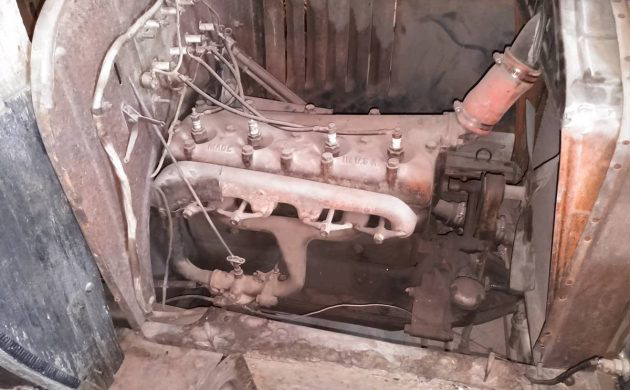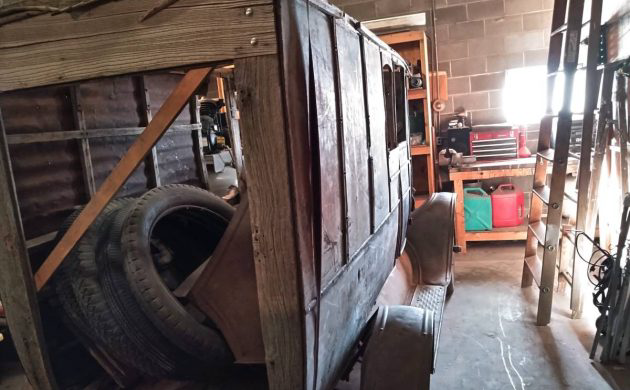Blank Slate 1917 Ford Model T Project
Henry Ford wasn’t the first automotive magnate to utilize the assembly line–that honor goes to Ransom Eli Olds. Ford just made it the best version of it, and his Model T became ubiquitous on American roads as the de facto first car of the people in the United States. It was affordable, simple, practical, and versatile. Model Ts came in every body configuration from roadster to sedan to sports car to pickup truck, all on the same basic frame and design, for nearly twenty years and fifteen million examples produced. This one used to deliver cigars in Denver, Colorado, and you can find it in Wyoming here on craigslist. Special thanks to Mark_K for letting us know about it!
Under the butterfly-hinged hood, you can find the standard 177 cubic inch (2.9 liter) inline four-cylinder engine making around 20 horsepower when new. The seller mentions that it doesn’t run currently, but with a little TLC it could. One of the clever engineering tricks Ford included in the Model T was its ability to run on multiple different fuels, and its lack of a water pump reduces complexity. It’s not a finicky engine, and I’m sure with a good cleaning it can run again.
Inside, there’s a basic cargo area out back. The passenger compartment looks to be missing the seats. Beyond that, though, it’s difficult to tell what else is missing. The simplicity of the car meant that instrumentation was limited, and it’s not like it was shipping from the factory with dual-zone automatic climate control. The beauty of the Model T is that it is the ultimate expression of “wheels, an engine, and seats.” There’s not much else there, there’s not much else that’s needed. The car can run fine without literally anything else.
The simplicity of the Model T means that even the most novice tinkerer (with halfway acceptable Google skills) can get a decent build out of it, and the fact that Ford made literally fifteen million of them a hundred years ago means parts (both OEM-spec and modified) are plentiful, and literally anything that could have been done to it has already been done. Would you restore it to how it undoubtedly looked in 1917? Would you make it a mobile billboard for your business? A work truck? A hot rod? What would your ultimate dream build be?
Auctions Ending Soon
 2002 Subaru Impreza WRXBid Now22 hours$333
2002 Subaru Impreza WRXBid Now22 hours$333
 1975 Chevrolet Corvette ConvertibleBid Now23 hours$4,000
1975 Chevrolet Corvette ConvertibleBid Now23 hours$4,000
 1964 Ford F-100 Camper CustomBid Now1 days$2,000
1964 Ford F-100 Camper CustomBid Now1 days$2,000
 2006 Jeep Wrangler SportBid Now2 days$11,000
2006 Jeep Wrangler SportBid Now2 days$11,000
 1974 Datsun 260ZBid Now4 days$750
1974 Datsun 260ZBid Now4 days$750





Comments
No water pump Hmmm. My Grandmother claimed that my Grandfather would build a fire under the motor of his Model T truck to thaw it out so it would start’ I trully wish they would have had video cameras back then, cause I would like to see that.
I had an old guy claim the he used to dip a corncob in kerosene and set it on the exhaust manifold and lite it to warm the engine up
Back in the 70s I watched a guy light a fire with charcoal under an AMC AMX to get her to start in 30 below weather. I was never so happy as to myself have a garage after seeing that debacle. He didn’t ruin the AMX and later that day he did drive by my place.
When Stalin decided the new Russian ZIS 110 limousine would be based on the 1942 Packard limousine, one of the changes they made involved the oil pump. Because the Packard’s oil pump was so powerful, if the driver was to try to start the car in the cold Siberian winters, with the straight 30W oil almost in a solid state, it could cause serious engine block damage.
So the ZIS version of the Packard 356 9-main bearing engine’s oil pump was modified, and can be seen as a big cast iron addition on the right side of the engine. On top of that pump can be found a “T” handle that can be screwed in and out as needed. Unscrewing the handle lowers the oil pressure so the engine can be safely started in -50f temperatures, and as the engine warms up, the handle can be screwed back in to keep the oil pressure up where it belongs, as the oil gets thinner with the rise in engine temperature.
I had the opportunity to inspect an armored version [known as the ZIS 115] on display at the Sinsheim Technical museum in Germany, and that car also has a oil pressure gauge next to the “T” handle so the driver can watch the gauge and adjust the oil pressure as needed. That car is said by the museum to have been one of the cars assigned to Stalin, so I don’t know if this gauge was on all the ZIS 110/115 cars or just those for Stalin’s use.
Even with a special kerosene heater that was placed under the engine and gearbox to help keep things a little bit warmer, the variable pressure oil pump was an absolute necessity during those insanely cold winters.
I was putting hot ashes in a ash pan and sliding it under my Datsun B210, in the early 80s. -20 to -30 fahrenheit, tended to be a little tough in my old Datsun, back then. Fifteen to twenty minutes of hot ashes under the oil pan and she’d spin like mid July.
Want to have some fun? Tell someone unfamiliar to “advance the spark”. Do what now? The lever behind the steering wheel, no, that’s the throttle, the other lever (up was retard, down advance) and watch the fun. I know, I’m kind of sick, but it was imperative to RETARD the spark, many found out why.
Okay, fun’s over, and we all know this isn’t something to go to work in, although with commute times, 5 mph is 5 mph. I do think, however, there are still enough Model T fans, that know full well how to operate them, and one of those folks will step forward. What happens when those folks are gone, doesn’t look too good for this stuff. What will probably happen, is someone will put it up on blocks, and make hot dog stand out of it. Food trucks being all the rage today.
Howard A, you couldn’t be more wrong.
Hey, at least I have something to say, putz, care to elaborate on what’s wrong?
There’s a restaurant in Naples Florida that has an early T flatbed, inside the building, that they use as the salad bar.
It just dawned on me – Anyone transporting this any distance at highway speed should probably do it in an enclosed trailer. I have a feeling that the “box” part of this truck would come apart in the wind. This would be a great father son project for a youngster.
pop cans, days gone by, sorry PJ the son wants a Honda not this old thing
The fire under the engine was to warm the engine oil so it could be cranked. In the old days, many men drained the oil at night and brought it into the house to keep it warm and then pour it back in when the car was started. I’ve been told they ran kerocene (#1 heating oil and lamp oil) in the radiator so it wouldn’t freeze.
Often, a cold start was assisted by jacking up one rear wheel to reduce driveline drag on the engine (remember, planetary transmission with no conventional clutch.) I have heard that some old timers would drain the engine oil and warm it up on the kitchen stove and refill the crankcase just before attempting the start. Of course, refilling the cooling system with warm water didn’t hurt, either. Most old-timers didn’t use anti-freeze, but drained the radiator after each use. The coolant available in those days was alcohol-based and boiled away easily, so plain water was the choice of most, despite the inconvenience. So adding preheated water was just part of the routine on a frigid starting attempt.
Jacking up one rear wheel served the purpose of helping the engine start because the the car was left in gear and the wheel acted like a heavy flywheel to keep the engine turning a bit longer. I know this because I did it more than once in the cold Michigan winters.
Yes, and now that I’m thinking about it, I believe Dad said he would sometimes turn the back wheel as Granddad turned the crank for an extra bit of momentum. Failing that, I expect they would hitch “Old Tommy” to the buggy and leave the “T” for a warmer day. The horse stayed around until after the T was replaced with an early A with the multiplate clutch and the emergency brake lever in the wrong place, but that’s a story for another day!